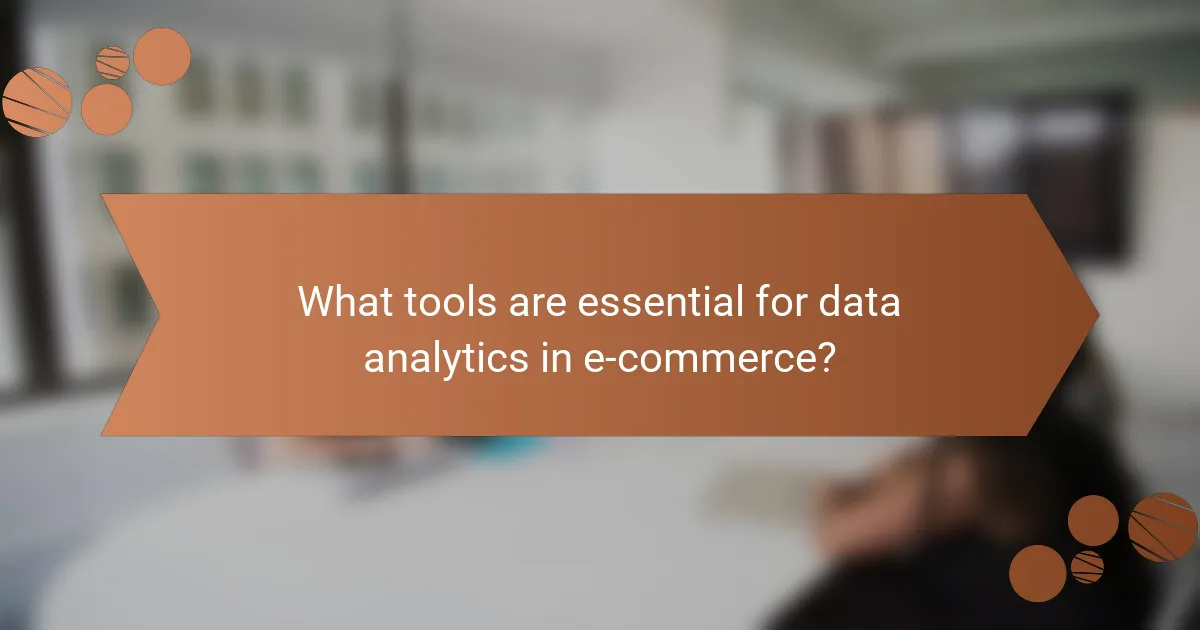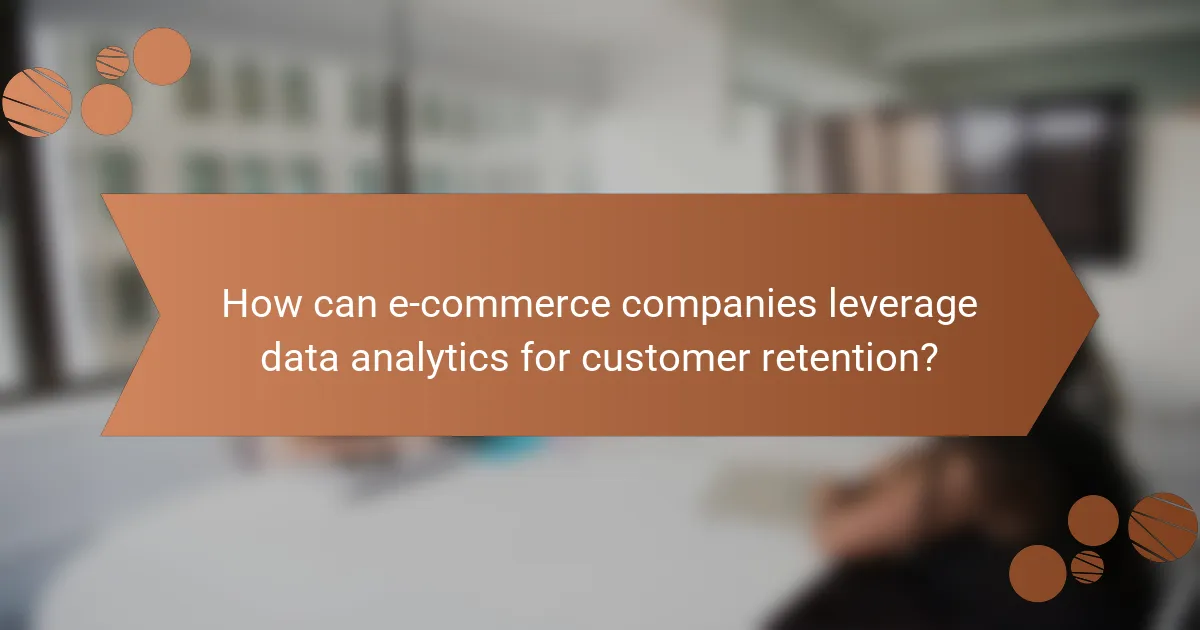Data analytics plays a crucial role in e-commerce by transforming raw data into actionable insights that drive decision-making. By understanding customer behavior and market trends, businesses can enhance efficiency and profitability. Current trends emphasize the use of AI, real-time data processing, and predictive analytics to improve customer experiences and operational effectiveness.

How can data analytics improve decision-making in e-commerce?
Data analytics enhances decision-making in e-commerce by providing actionable insights derived from customer behavior, sales patterns, and market trends. By leveraging these insights, businesses can make informed choices that lead to increased efficiency and profitability.
Enhanced customer insights
Data analytics allows e-commerce businesses to gain a deeper understanding of their customers’ preferences and behaviors. By analyzing purchase history, browsing patterns, and demographic information, companies can identify trends and tailor their offerings accordingly.
For example, if analytics reveal that a significant portion of customers prefers eco-friendly products, a retailer can adjust its inventory to feature more sustainable options. This targeted approach not only meets customer demand but also fosters brand loyalty.
Optimized inventory management
Effective inventory management is crucial for e-commerce success, and data analytics plays a key role in optimizing stock levels. By analyzing sales data and seasonal trends, businesses can predict demand more accurately and reduce excess inventory.
For instance, if analytics indicate that certain products sell well during specific months, retailers can adjust their stock accordingly, minimizing the risk of overstocking or stockouts. This proactive approach can lead to improved cash flow and reduced storage costs.
Targeted marketing strategies
Data analytics enables e-commerce companies to develop targeted marketing strategies that resonate with specific customer segments. By segmenting customers based on their behaviors and preferences, businesses can create personalized campaigns that drive engagement and conversions.
For example, using customer data, a retailer might send tailored email promotions to different segments, such as first-time buyers or repeat customers, increasing the likelihood of purchase. This targeted marketing not only improves customer experience but also enhances return on investment (ROI) for marketing efforts.

What are the current trends in data analytics for e-commerce?
Current trends in data analytics for e-commerce focus on enhancing customer experience and operational efficiency. Key developments include the integration of AI and machine learning, real-time data processing, and the growing adoption of predictive analytics.
AI and machine learning integration
AI and machine learning are transforming data analytics in e-commerce by automating data processing and providing deeper insights. These technologies enable businesses to analyze customer behavior patterns, optimize pricing strategies, and personalize marketing efforts effectively.
For instance, e-commerce platforms can use machine learning algorithms to recommend products based on previous purchases, increasing conversion rates. Companies should consider investing in AI tools that integrate seamlessly with existing systems to maximize their benefits.
Real-time data processing
Real-time data processing allows e-commerce businesses to make immediate decisions based on current data. This capability is crucial for responding to market changes, customer inquiries, and inventory management swiftly.
For example, retailers can adjust their promotional strategies in real-time based on customer engagement metrics. Implementing real-time analytics tools can help businesses stay competitive, but they should ensure they have the necessary infrastructure to support such systems.
Predictive analytics adoption
Predictive analytics is increasingly adopted in e-commerce to forecast trends and customer behavior. By analyzing historical data, businesses can anticipate future sales, inventory needs, and customer preferences.
For instance, a retailer might use predictive models to identify which products are likely to be popular in the upcoming season, allowing for better stock management. Companies should prioritize data quality and invest in training staff to interpret predictive insights effectively.

What tools are essential for data analytics in e-commerce?
Essential tools for data analytics in e-commerce include platforms that help track user behavior, visualize data, and generate actionable insights. These tools enable businesses to make informed decisions based on customer interactions and market trends.
Google Analytics
Google Analytics is a powerful tool for tracking and analyzing website traffic. It provides insights into user behavior, conversion rates, and traffic sources, helping e-commerce businesses understand how customers interact with their sites.
To effectively use Google Analytics, set up goals to track specific actions like purchases or sign-ups. Regularly review reports on user demographics and behavior to identify trends and areas for improvement.
Tableau
Tableau is a data visualization tool that transforms complex data sets into interactive, easy-to-understand visual formats. It allows e-commerce businesses to create dashboards that display key performance indicators and sales trends at a glance.
When using Tableau, focus on integrating data from various sources, such as sales platforms and customer relationship management systems. This holistic view can uncover insights that drive strategic decisions and enhance customer experiences.
Power BI
Power BI is a business analytics tool by Microsoft that enables users to visualize data and share insights across their organization. It is particularly useful for e-commerce companies looking to analyze sales performance and customer engagement metrics.
To maximize Power BI’s potential, connect it to your existing data sources, such as Excel spreadsheets or SQL databases. Regularly update your reports to reflect real-time data, ensuring that your decision-making is based on the latest information available.

How do businesses choose the right data analytics platform?
Businesses choose the right data analytics platform by evaluating their specific needs, including scalability, cost, and user experience. A well-suited platform should align with the organization’s goals and facilitate effective decision-making through data insights.
Scalability options
Scalability is crucial for businesses anticipating growth or fluctuating data needs. Companies should consider whether the platform can handle increasing data volumes and user loads without performance degradation. Options may include cloud-based solutions that offer flexible resources or on-premises systems that require hardware upgrades.
For example, a small startup might start with a basic plan that supports a few users and limited data, while a larger enterprise may need a solution that can scale to thousands of users and petabytes of data. It’s essential to assess future growth projections when selecting a platform.
Cost considerations
Cost is a significant factor in choosing a data analytics platform, as expenses can vary widely based on features, user licenses, and support. Businesses should evaluate both upfront costs and ongoing expenses, such as subscription fees or maintenance costs. A clear understanding of the total cost of ownership is vital.
For instance, a platform with a lower initial cost may have higher long-term expenses due to additional features or support. Companies should also consider potential ROI from improved decision-making and efficiency when weighing costs against benefits.
User-friendly interfaces
A user-friendly interface is essential for ensuring that team members can effectively utilize the data analytics platform. Platforms should offer intuitive navigation, clear visualizations, and easy access to key features. This reduces the learning curve and enhances overall productivity.
For example, platforms that provide drag-and-drop functionality for creating reports or dashboards can significantly improve user experience. Businesses should prioritize platforms that offer training resources and customer support to assist users in maximizing the tool’s capabilities.

What are the challenges of implementing data analytics?
Implementing data analytics presents several challenges that organizations must navigate to leverage insights effectively. Key issues include data privacy concerns, integration with existing systems, and skill gaps within the workforce.
Data privacy concerns
Data privacy is a significant challenge in data analytics, especially with regulations like GDPR in Europe and CCPA in California. Organizations must ensure that personal data is handled responsibly and that users’ consent is obtained before data collection.
To address these concerns, companies should implement robust data governance frameworks and utilize anonymization techniques. Regular audits and compliance checks can help mitigate risks associated with data breaches and misuse.
Integration with existing systems
Integrating data analytics tools with existing systems can be complex and resource-intensive. Organizations often face compatibility issues, data silos, and the need for significant system upgrades or replacements.
To facilitate smoother integration, businesses should conduct thorough assessments of their current infrastructure and identify potential gaps. Employing middleware solutions or APIs can streamline data flow and enhance interoperability between systems.
Skill gaps in workforce
A lack of skilled personnel is a common barrier to effective data analytics implementation. Many organizations struggle to find employees with the necessary expertise in data science, analytics tools, and statistical methods.
To bridge this gap, companies can invest in training programs and partnerships with educational institutions. Additionally, hiring consultants or leveraging freelance experts can provide immediate support while building internal capabilities over time.

How can e-commerce companies leverage data analytics for customer retention?
E-commerce companies can utilize data analytics to enhance customer retention by understanding shopping behaviors, personalizing experiences, and optimizing loyalty programs. By analyzing customer data, businesses can create targeted strategies that foster loyalty and increase repeat purchases.
Personalized shopping experiences
Data analytics enables e-commerce companies to offer personalized shopping experiences tailored to individual customer preferences. By tracking browsing history, purchase patterns, and demographic information, businesses can recommend products that align with a customer’s interests.
For instance, using algorithms, companies can create dynamic product recommendations on their websites or through email marketing campaigns. This approach can significantly increase conversion rates, as customers are more likely to purchase items that resonate with their tastes.
Loyalty program optimization
Optimizing loyalty programs through data analytics can enhance customer retention by providing rewards that truly matter to customers. By analyzing participation rates and reward redemption patterns, companies can adjust their programs to better meet customer expectations.
For example, a retailer might find that customers prefer discounts over points accumulation. Adjusting the loyalty program to offer immediate discounts can lead to higher engagement and repeat purchases. Regularly reviewing program effectiveness ensures that it remains attractive and relevant.
Customer feedback analysis
Analyzing customer feedback is crucial for understanding satisfaction levels and improving retention strategies. E-commerce companies can collect feedback through surveys, reviews, and social media, then use data analytics to identify trends and areas for improvement.
For instance, if feedback indicates long shipping times are a common complaint, a company can investigate logistics and make necessary adjustments. Addressing these concerns promptly can enhance customer satisfaction and foster loyalty, leading to increased retention rates.



